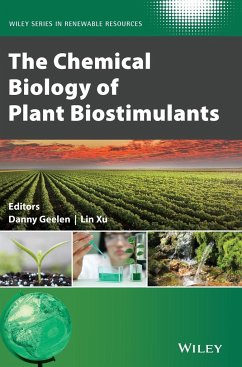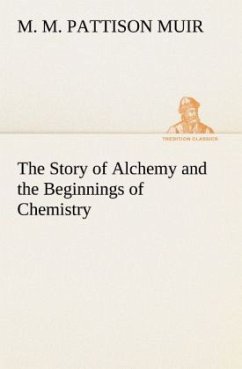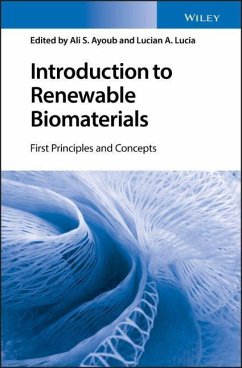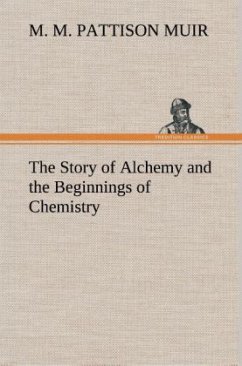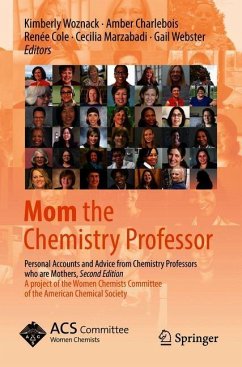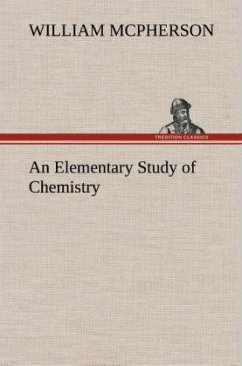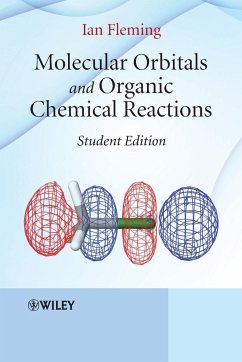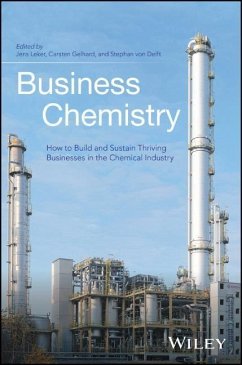Nicht lieferbar
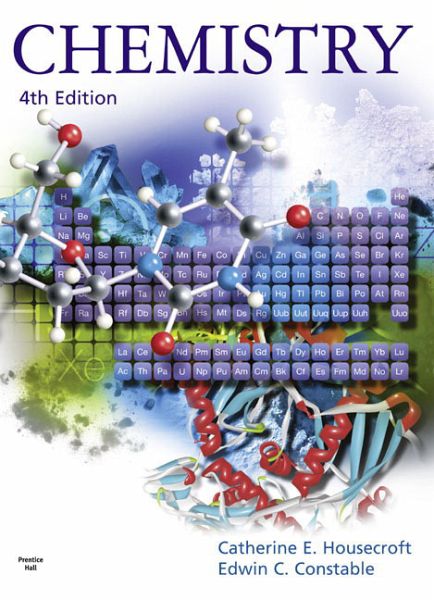
Chemistry
Versandkostenfrei!
Nicht lieferbar
Chemistry provides a robust coverage of the different branches of chemistry with unique depth in organic chemistry in an introductory text helping students to develop a solid understanding of chemical principles, how they interconnect and how they can be applied to our lives.Product Description Chemistry provides a robust coverage of the different branches of chemistry with unique depth in organic chemistry in an introductory text helping students to develop a solid understanding of chemical principles, how they interconnect and how they can be applied to our lives. Covers Physic...
Chemistry provides a robust coverage of the different branches of chemistry with unique depth in organic chemistry in an introductory text helping students to develop a solid understanding of chemical principles, how they interconnect and how they can be applied to our lives.
Product Description
Chemistry provides a robust coverage of the different branches of chemistry with unique depth in organic chemistry in an introductory text helping students to develop a solid understanding of chemical principles, how they interconnect and how they can be applied to our lives.
Covers Physical Chemistry in an accessible format for first years...good for covering the gap between varied levels of knowledge from different schools' curricula and the mcuh more demanding University courses. - Dr Ritu Kataky, DEPT OF CHEMISTRY, UNIVERSITY OF DURHAM
Features + Benefits
Chapters are grouped into inorganic, physical and organic components, with integrating themes highlighted throughout. This provides flexibility and highlights the connections between different areas.
Topic boxes throughout the book highlight the applications of chemistry in industry, biology, the environment and the laboratory. These help students to understand the relevance of chemistry to everyday life.
Definition boxes and end-of-chapter checklists provide excellent revision aids.
End-of-chapter problems reinforce learning and develop subject knowledge.
Chapters are grouped into inorganic, physical and organic components, with integrating themes highlighted throughout. This provides flexibility and helps students to see the connections between different areas.
Topic boxes throughout the book highlight the applications of chemistry in industry, biology, the environment and laboratory.
Worked examples throughout guide students through topics and help them to develop strong problem-solving and critical-thinking skills.
Assumes minimal mathematical background, and explains any use of mathematics descriptively and using diagrams wherever possible. A Mathematics Tutor is also provided on the website to support students as they learn.
The text is four-colour throughout with 3D computer-generated artwork, and is supported by CHIME graphics on the website, helping students to visualise the chemistry.
Backcover
Chemistry
Fourth Edition
Chemistry provides robust coverage of all aspects of a first year undergraduate chemistry course with unique depth in organic chemistry in an introductory text helping students to develop a solid understanding of chemical principles, how they interconnect and how they can be applied to our lives.
MASTERING CHEMISTRY
MasteringChemistry is the most advanced chemistry homework and tutorial system. Drawing on a research-enhanced library of problems that cover the entire general chemistry course, MasteringChemistry provides personal tutoring to students with immediate and specific feedback culminating in proven positive results.
See the guided tour inside to find out how Mastering Chemistry could help you.
Mastering proved to be a convenient, robust and totally reliable way of delivering weekly assignments covering all aspects of our first year course there was a tangible improvement in both the level of engagement and quality of learning ... in all, a great success.
Gordon McDougal, University of Edinburgh
Chapters are grouped into inorganic, physical, organic and analytical components, with integrating themes highlighted throughout. This provides flexibility and highlights the connections between different areas.
Topic boxes throughout the book highlight the applications of chemistry in industry, biology, medicine, the environment and the laboratory. The choice of topics ensures that students understand the relevance of chemistry to everyday life.
A new chapter, Chemistry in the workplace introduces analytical techniques within the context of solving problems (pharmaceutical, forensic, environmental, commercial) in daily life.
Extended discussions of the relevance of chemistry to biology, medicine and the environment.
Definition boxes and end-of-chapter checklists provide excellent revision aids.
End-of-chapter problems reinforce learning and develop subject knowledge. Each chapter also includes a new Chemistry in daily use set of problems.
A companion website at www.pearsoned.co.uk/housecroft features multiple-choice questions, rotatable 3-dimensional molecular structures, and a Mathematics Tutor. For full information and details of the Mastering Chemistry resource available with this book, see the Guided Tour.
Catherine E. Housecroft and Edwin C. Constable are both Professors of Chemistry at the University of Basel, Switzerland. They have extensive international teaching experience and their research interests include supramolecular and organometallic chemistries, nanotechnology, molecular devices and dye-sensitized solar cells. In 1997 Professor Constable was awarded the prestigious Howard lectureship for pre-eminence in organic chemistry or related disciplines by the University of Sydney, Australia.
Preface
Guided tour
Acknowledgements
About the authors
1. Some basic concepts
2. Thermochemistry
3. Atoms and atomic structure.
4. Homonuclear covalent bonds
5. Heteronuclear diatomic molecules
6. Polyatomic molecules: shapes
7. Polyatomic molecules: bonding
8. Ions
9. Elements
10. Mass spectrometry
11. Introduction to spectroscopy
12. Vibrational and rotational spectroscopies
13. Electronic spectroscopy
14. NMR spectroscopy
15. Reaction kinetics
16. Equilibria
17. Thermodynamics
18. Electrochemistry
19. The conductivity of ions in solution
20. Periodicity
21. Hydrogen and the s-block elements
22. p-Block and high oxidation state d-block elements
23. Coordination complexes of the d-block metals
24. Carbon compounds: an introduction
25. Acyclic and cyclic alkanes
26. Alkenes and alkynes
27. Polar organic molecules: an introduction
28. Halogenoalkanes
29. Ethers
30. Alcohols
31. Amines
32. Aromatic compounds
33. Carbonyl compounds
34. Aromatic heterocyclic compounds
35. Molecules in nature
36. Chemistry in the workplace
Appendices
Answers to end-of-chapter problems
Index
Product Description
Chemistry provides a robust coverage of the different branches of chemistry with unique depth in organic chemistry in an introductory text helping students to develop a solid understanding of chemical principles, how they interconnect and how they can be applied to our lives.
Covers Physical Chemistry in an accessible format for first years...good for covering the gap between varied levels of knowledge from different schools' curricula and the mcuh more demanding University courses. - Dr Ritu Kataky, DEPT OF CHEMISTRY, UNIVERSITY OF DURHAM
Features + Benefits
Chapters are grouped into inorganic, physical and organic components, with integrating themes highlighted throughout. This provides flexibility and highlights the connections between different areas.
Topic boxes throughout the book highlight the applications of chemistry in industry, biology, the environment and the laboratory. These help students to understand the relevance of chemistry to everyday life.
Definition boxes and end-of-chapter checklists provide excellent revision aids.
End-of-chapter problems reinforce learning and develop subject knowledge.
Chapters are grouped into inorganic, physical and organic components, with integrating themes highlighted throughout. This provides flexibility and helps students to see the connections between different areas.
Topic boxes throughout the book highlight the applications of chemistry in industry, biology, the environment and laboratory.
Worked examples throughout guide students through topics and help them to develop strong problem-solving and critical-thinking skills.
Assumes minimal mathematical background, and explains any use of mathematics descriptively and using diagrams wherever possible. A Mathematics Tutor is also provided on the website to support students as they learn.
The text is four-colour throughout with 3D computer-generated artwork, and is supported by CHIME graphics on the website, helping students to visualise the chemistry.
Backcover
Chemistry
Fourth Edition
Chemistry provides robust coverage of all aspects of a first year undergraduate chemistry course with unique depth in organic chemistry in an introductory text helping students to develop a solid understanding of chemical principles, how they interconnect and how they can be applied to our lives.
MASTERING CHEMISTRY
MasteringChemistry is the most advanced chemistry homework and tutorial system. Drawing on a research-enhanced library of problems that cover the entire general chemistry course, MasteringChemistry provides personal tutoring to students with immediate and specific feedback culminating in proven positive results.
See the guided tour inside to find out how Mastering Chemistry could help you.
Mastering proved to be a convenient, robust and totally reliable way of delivering weekly assignments covering all aspects of our first year course there was a tangible improvement in both the level of engagement and quality of learning ... in all, a great success.
Gordon McDougal, University of Edinburgh
Chapters are grouped into inorganic, physical, organic and analytical components, with integrating themes highlighted throughout. This provides flexibility and highlights the connections between different areas.
Topic boxes throughout the book highlight the applications of chemistry in industry, biology, medicine, the environment and the laboratory. The choice of topics ensures that students understand the relevance of chemistry to everyday life.
A new chapter, Chemistry in the workplace introduces analytical techniques within the context of solving problems (pharmaceutical, forensic, environmental, commercial) in daily life.
Extended discussions of the relevance of chemistry to biology, medicine and the environment.
Definition boxes and end-of-chapter checklists provide excellent revision aids.
End-of-chapter problems reinforce learning and develop subject knowledge. Each chapter also includes a new Chemistry in daily use set of problems.
A companion website at www.pearsoned.co.uk/housecroft features multiple-choice questions, rotatable 3-dimensional molecular structures, and a Mathematics Tutor. For full information and details of the Mastering Chemistry resource available with this book, see the Guided Tour.
Catherine E. Housecroft and Edwin C. Constable are both Professors of Chemistry at the University of Basel, Switzerland. They have extensive international teaching experience and their research interests include supramolecular and organometallic chemistries, nanotechnology, molecular devices and dye-sensitized solar cells. In 1997 Professor Constable was awarded the prestigious Howard lectureship for pre-eminence in organic chemistry or related disciplines by the University of Sydney, Australia.
Preface
Guided tour
Acknowledgements
About the authors
1. Some basic concepts
2. Thermochemistry
3. Atoms and atomic structure.
4. Homonuclear covalent bonds
5. Heteronuclear diatomic molecules
6. Polyatomic molecules: shapes
7. Polyatomic molecules: bonding
8. Ions
9. Elements
10. Mass spectrometry
11. Introduction to spectroscopy
12. Vibrational and rotational spectroscopies
13. Electronic spectroscopy
14. NMR spectroscopy
15. Reaction kinetics
16. Equilibria
17. Thermodynamics
18. Electrochemistry
19. The conductivity of ions in solution
20. Periodicity
21. Hydrogen and the s-block elements
22. p-Block and high oxidation state d-block elements
23. Coordination complexes of the d-block metals
24. Carbon compounds: an introduction
25. Acyclic and cyclic alkanes
26. Alkenes and alkynes
27. Polar organic molecules: an introduction
28. Halogenoalkanes
29. Ethers
30. Alcohols
31. Amines
32. Aromatic compounds
33. Carbonyl compounds
34. Aromatic heterocyclic compounds
35. Molecules in nature
36. Chemistry in the workplace
Appendices
Answers to end-of-chapter problems
Index




